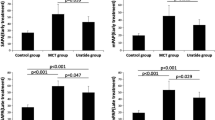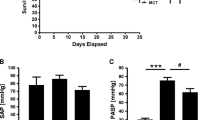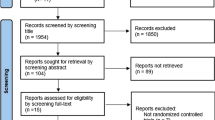Abstract
Pulmonary arterial hypertension (PAH) is a progressive and a life-threatening disease with its high morbidity and mortality ratios. On searching for new shining targets in pathogenesis, we noticed, in our previous studies, urotensin-II (UII) in systemic sclerosis with potent angiogenic and pro-fibrotic features. Owing to the mimicking properties of UII with endothelin-1 (ET1), we attempted to investigate the effect of palosuran in a PAH rat model. Thirty rats were randomly divided into three groups, with each group comprising 10 rats: group 1 (control group) received the vehicle subcutaneously, instead of monocrotaline (MCT) and vehicle; group 2 (MCT group) received subcutaneous MCT and vehicle; and group 3 (MCT + palosuran group) received subcutaneous MCT and palosuran. Serum UII, ET1, transforming growth factor-β1 (TGF-β1) levels, pulmonary arteriolar pathology of different diameter vessels, and cardiac indices were evaluated. The ET1, TGF-β1, and UII levels were significantly diminished in the treatment group, similar to the controls (p < 0.001). Right ventricular hypertrophy index and mean pulmonary arterial pressure scores were also significantly reduced in the treatment group (p = 0.001). Finally, in the 50–125-μm diameter arterioles, in contrast to Groups 3 and 1, there was a statistically significant thickness (p < 0.01) in the arteriolar walls of rats in Group 2. The treatment effect on arteries of more than 125-μm diameters was found to be valuable but not significant. Owing to its healing effect on hemodynamic, histological, and biochemical parameters of MCT-induced PAH, palosuran as an antagonist of UII might be an optional treatment alternative for PAH.




Similar content being viewed by others
References
McLaughlin, V.V., and M.D. McGoon. 2006. Pulmonary arterial hypertension. Circulation 114: 1417–1431.
Kim, N.H.S., and L.J. Rubin. 2002. Endothelin in health and disease: Endothelin receptor antagonists in the management of pulmonary artery hypertension. Journal of Cardiovascular Pharmacology Therapeutics 7: 9–19.
Maguire, J.J., R.E. Kuc, and A.P. Davenport. 2000. Orphan-receptor ligand human urotensin II: Receptor localization in human tissues and comparison of vasoconstrictor responses with endothelin-1. British Journal of Pharmacology 131: 441–446.
Ames, R.S., H.M. Sarau, J.K. Chambers, R.N. Willette, N.V. Aiyar, A.M. Romanic, et al. 1999. Human urotensin-II is a potent vasoconstrictor and agonist for the orphan receptor GPR14. Nature 401: 282–286.
Hillier, C., C. Berry, M.C. Petrie, P.J. O'Dwyer, C. Hamilton, A. Brown, et al. 2001. Effects of urotensin II in human arteries and veins of varying caliber. Circulation 103: 1378–1381.
Giebing, G., M. Tölle, J. Jürgensen, J. Eichhorst, J. Furkert, M. Beyermann, et al. 2005. Arrestin-independent internalization and recycling of the urotensin receptor contribute to long-lasting urotensin II-mediated vasoconstriction. Circulation Research 97: 707–715.
Djordjevic, T. 2007. Görlach A. Urotensin-II in the lung: A matter for vascular remodelling and pulmonary hypertension? Thrombosis and Haemostasis 98: 952–962.
Maguire, J.J., and A.P. Davenport. 2002. Is urotensin-II the new endothelin? British Journal of Pharmacology 137: 579–588.
Pehlivan, Y., A.M. Onat, G. Comez, and T. Babacan. 2011. Urotensin-II in systemic sclerosis: A new peptide in pathogenesis. Clinical Rheumatology 30: 837–842.
Pehlivan, Y., B. Gogebakan, S. Oztuzcu, M. Ozgen, G.Y. Cetin, R. Bayraktar, et al. 2012. Association between Thr21Met and Ser89Asn polymorphisms of the urotensin II Gene and systemic sclerosis. The Journal of Rheumatology 39: 106–111.
Onat, A.M., I. Turkbeyler, Y. Pehlivan, T. Demir, D.S. Kaplan, S. Taysi, et al. 2010. Urotensin II antogonism with palosuran: A new treatment in pulmonary arterial hypertension. Annals of the Rheumatic Diseases 69(suppl3): 410.
Mei, Y., H. Jin, W. Tian, H. Wang, H. Wang, Y. Zhao, et al. 2011. Urantide alleviates monocrotaline induced pulmonary arterial hypertension in Wistar rats. Pulmonary Pharmacology & Therapeutics 24: 386–393.
Clozel, M., C. Binkert, M. Birker-Robaczewska, C. Boukhadra, S.S. Ding, W. Fischli, et al. 2004. Pharmacology of the urotensin-II receptor antagonist palosuran (ACT-058362; 1-[2-(4-benzyl-4-hydroxy-piperidin-1-yl)-ethyl]-3-(2-methyl- quinolin-4-yl)-urea sulfate salt): First demonstration of a pathophysiological role of the urotensin system. The Journal of Pharmacology and Experimental Therapeutics 311: 204–212.
Alexandru, B., and M.A. Bogdan. 2001. Monocrotaline induces pulmonary hypertension in animal models. Pneumologia 50: 85–89.
Clozel, M., P. Hess, C. Qiu, S.S. Ding, and M. Rey. 2006. The urotensin-II receptor antagonist palosuran improves pancreatic and renal function in diabetic rats. The Journal of Pharmacology and Experimental Therapeutics 316: 1115–1121.
Stinger, R.B., V.J. Iacopino, I. Alter, T.M. Fitzpatrick, J.C. Rose, and P.A. Kot. 1981. Catheterization of the pulmonary artery in the closed-chest rat. Journal of Applied Physiology 51: 1047–1050.
Zhu, X.D., D.M. Shi, Z.C. Jing, Z.C. Jing, L. Li, D. Ma, et al. 2010. The effects of atorvastatin on pulmonary arterial hypertension and expression of p38, p27, and Jab1 in rats. International Journal of Molecular Medicine 26: 541–547.
Varagic, J., E.D. Frohlich, J. Díez, D. Susic, J. Ahn, A. González, et al. 2006. Myocardial fibrosis, impaired coronary hemodynamics, and biventricular dysfunction in salt-loaded SHR. American Journal of Physiology. Heart and Circulatory Physiology 290: 1503–1509.
Robbins, I.M. 2004. Advancing therapy for pulmonary arterial hypertension: Can animal models help? American Journal of Respiratory and Critical Care Medicine 169: 5–6.
McLaughlin, V.V., S.L. Archer, D.B. Badesch, R.J. Barst, H.W. Farber, J.R. Lindner, et al. 2009. American College of Cardiology Foundation Task Force on Expert Consensus Documents; American Heart Association; American College of Chest Physicians; American Thoracic Society, Inc; Pulmonary Hypertension Association: ACCF/AHA 2009 expert consensus document on pulmonary hypertension a report of the American College of Cardiology Foundation Task Force on Expert Consensus Documents and the American Heart Association developed in collaboration with the AmericanCollege of Chest Physicians; American Thoracic Society, Inc.; and the Pulmonary Hypertension Association. Journal of the American College of Cardiology 53: 1573–1619.
Essop, M.R. 2010. Contemporary insights into the pathogenesis, diagnosis and therapy of pulmonary arterial hypertension. Cardiovascular Journal of Africa 21: 334–337.
Stewart, D.J., R.D. Levy, P. Cernacek, and D. Langleben. 1991. Increased plasma endothelin-1 in pulmonary hypertension: Marker or mediator of disease? Annals of Internal Medicine 114: 464–469.
Rubens, C., R. Ewert, M. Halank, R. Wensel, H.D. Orzechowski, H.P. Schultheiss, et al. 2001. Big endothelin-1 and endothelin-1 plasma levels are correlated with the severity of primary pulmonary hypertension. Chest 120: 1562–1569.
Djordjevic, T., R.S. BelAiba, S. Bonello, J. Pfeilschifter, J. Hess, and A. Görlach. 2005. Human urotensin II is a novel activator of NADPH oxidase in human pulmonary artery smooth muscle cells. Arteriosclerosis, Thrombosis, and Vascular Biology 25: 519–525.
Qi, J., J. Du, X. Tang, J. Li, B. Wei, and C. Tang. 2004. The upregulation of endothelial nitric oxide synthase and urotensin-II is associated with pulmonary hypertension and vascular diseases in rats produced by aortocaval shunting. Heart and Vessels 19: 81–88.
MacLean, M.R., D. Alexander, A. Stirrat, M. Gallagher, S.A. Douglas, E.H. Ohlstein, et al. 2000. Contractile responses to human urotensin-II in rat and human pulmonary arteries: Effect of endothelial factors and chronic hypoxia in the rat. British Journal of Pharmacology 130: 201–204.
Albertin, G., D. Guidolin, E. Sorato, R. Spinazzi, A. Mascarin, B. Oselladore, et al. 2009. Pro-angiogenic activity of Urotensin-II on different human vascular endothelial cell populations. Regulatory Peptides 157: 64–71.
Loirand, G., P. Guerin, and P. Pacaud. 2006. Rho kinases in cardiovascular physiology and pathophysiology. Circulation Research 98: 322–334.
Abe, K., H. Shimokawa, K. Morikawa, T. Uwatoku, K. Oi, Y. Matsumoto, et al. 2004. Long-term treatment with a Rho-kinase inhibitor improves monocrotaline-induced fatal pulmonary hypertension in rats. Circulation Research 94: 385–393.
Oka, M., K.A. Fagan, P.L. Jones, and I.F. McMurtry. 2008. Therapeutic potential of RhoA/Rho kinase inhibitors in pulmonary hypertension. British Journal of Pharmacology 155: 444–454.
Fukumoto, Y., T. Matoba, A. Ito, H. Tanaka, T. Kishi, S. Hayashidani, et al. 2005. Acute vasodilator effects of a Rho-kinase inhibitor, fasudil, in patients with severe pulmonary hypertension. Heart 91: 391–392.
Fujita, H., Y. Fukumoto, K. Saji, K. Sugimura, J. Demachi, J. Nawata, et al. 2010. Acute vasodilator effects of inhaled fasudil, a specific Rhokinase inhibitor, in patients with pulmonary arterial hypertension. Heart and Vessels 25: 144–149.
Ishikura, K., N. Yamada, M. Ito, S. Ota, M. Nakamura, N. Isaka, et al. 2006. Beneficial acute effects of Rho-kinase inhibitor in patients with pulmonary arterial hypertension. Circulation Journal 70: 174–178.
Sauzeau, V., E.L. Mellionnec, J. Bertoglio, E. Scalbert, P. Pacaud, and G. Loirand. 2001. Human urotensin II-induced contraction and arterial smooth muscle cell proliferation are mediated by Rho A and Rho-kinase. Circulation Research 88: 1102–1104.
Watanabe, T., R. Pakala, T. Katagiri, and C.R. Benedict. 2001. Synergistic effect of urotensin II with serotonin on vascular smooth muscle cell proliferation. Journal of Hypertension 19: 2191–2196.
Rossowski, W.J., B.L. Cheng, J.E. Taylor, R. Datta, and D.H. Coy. 2002. Human urotensin II-induced aorta ring contractions are mediated by protein kinase C, tyrosine kinases and Rho-kinase: Inhibition by somatostatin receptor antagonists. European Journal of Pharmacology 438: 159–170.
Acknowledgments
We are very grateful to Actelion Pharmaceuticals Ltd. (Allschwil, Switzerland) for providing palosuran samples.
Conflict of Interest
None
Author information
Authors and Affiliations
Corresponding author
Rights and permissions
About this article
Cite this article
Onat, A.M., Pehlivan, Y., Turkbeyler, I.H. et al. Urotensin Inhibition with Palosuran Could Be a Promising Alternative in Pulmonary Arterial Hypertension. Inflammation 36, 405–412 (2013). https://doi.org/10.1007/s10753-012-9559-x
Published:
Issue Date:
DOI: https://doi.org/10.1007/s10753-012-9559-x




